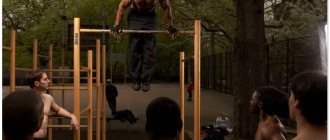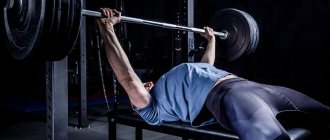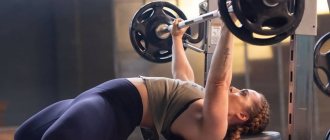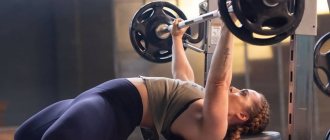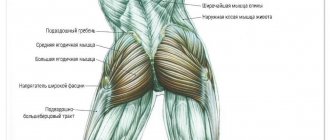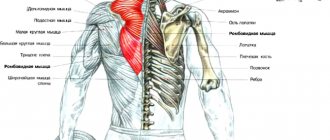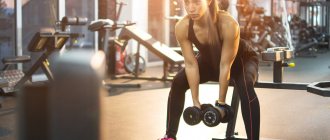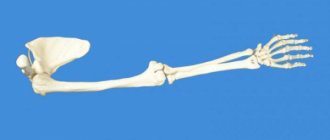It is impossible to build a beautiful athletic body without a developed back, but even when “pumping up” it, you cannot get by with one or two types of training. One of the important parts of the muscle texture of the shoulder girdle and back is the so-called “trapezoid”, the appearance of which completes the composition of an athletic physique.
It received this name among bodybuilders and athletes for its external similarity with the geometric figure of the same name.
Structure
The muscle itself can be divided into several parts:
- superior, levator scapulae and shoulder girdle
- middle, moving the scapulae towards the spine
- lower, lowering the shoulder girdle and scapular part
Each of them can be developed and pumped up, for which training with your own and free weights was developed.
You can strengthen this part in several ways, including, there are exercises for the trapezius muscles that can be performed at home.
Before classes start
Let us note a few important points that you should know before training:
- It makes no sense to load this muscle group more than once a week.
- You should not do more than 1-2 exercises during one workout.
- Depending on your genetics, you will have to put in a different amount of effort. For some, it grows harmoniously with the whole body when performing basic training; for others, it has difficulty responding to an isolated high-quality load.
- The trapezoid loves “pumping”. That is, a large number of repetitions with a short rest period.
By following these recommendations, you can be guaranteed to achieve success in the first two months of classes; you will not study in vain.
Features of training
Since the functions of different parts of the trapezius muscle are different, different exercises are needed to train each of them. The middle and lower trapezius area is well worked out when pumping up the back muscles - any type of bent-over rows, shoulder presses (lifting weights overhead).
But the upper part of the trapezius is not worked enough during basic back training. Therefore, there are special types of exercises for it - shrugs. These are exercises for raising the shoulders with weights in the lowered arms.
Targeted pumping of the trapezius is carried out on back training days, after performing basic exercises. It is enough to perform 2-3 exercises in 4-5 approaches with minute pauses. To avoid addiction, exercises should be changed. As strength increases, working weights must be increased, maintaining the number of repetitions until muscle failure in the range of 7-10 times.
Basis. "First Shrugs"
The simplest and most affordable option for home would be exercises for the trapezius muscles with dumbbells.
The most popular and easiest option for beginners to master is the so-called “shrugs”. The implementation is extremely simple, you just need to understand the basic principle:
Stand up straight, take a projectile in each hand. We keep our hands “at the seams”, our feet shoulder-width apart and begin to pull the dumbbells upward with a trapezoid so that the shoulders rise as high as possible, at the top point we hold the dumbbells for 1 second.
We take weight from 8-10 kg or more, depending on the level of preparedness. You need to perform 3 sets of 28-30 repetitions.
Thus, you will “pump up” the upper part of the muscles and partially the middle.
This is important: forearms, shoulders, biceps - nothing except the trapezius should not strain and take part in the training.
What not to do:
- Try not to tuck your chin to your chest - this can cause neck injury in the long run.
- If you are a beginner, do not take a lot of weight, you need to start with a small load, focusing on the correct technique.
- Do not tilt your body; it is important to stay straight, without leaning to the sides.
- Don't hold your breath for too long. Do the exercise while exhaling.
There is a similar version of the exercise for the trapezius muscle of the back, but for more advanced athletes working with heavy weights.
Instead of dumbbells, a barbell with weight plates is used. The principle of the lesson is the same. Take the bar with a reverse grip, stand straight, feet shoulder-width apart. You can hold the barbell even behind your back, it doesn’t matter.
The number of repetitions and approaches is the same, only the working weight and psychological attitude towards training change.
What should the opposite sex do? The principle of performing exercises on the trapezius back muscles for women is no different from men. Only the degree of preparation (due to physiology) and starting weights differ.
Lifting dumbbells from a bench
Lie face down on a bench with your feet on the floor. Take one projectile in each hand. Next, raise your arms with dumbbells until your shoulder blades close together. The weight is taken depending on the level of training. Do 3 sets of 14-20 repetitions.
Another effective exercise for the lower trapezius muscles is the lying reverse dumbbell fly. In this case, you need to use strictly light or medium weights.
You need to take dumbbells in each hand. Lie on the bench on your stomach, placing your feet on the floor, as in the previous lesson.
We begin to spread our arms until our arms become parallel to the floor. We linger at the top point for 1-2 seconds.
Reasons for development
- Often, shoulder disease develops against the background of cervical osteochondrosis, when degenerative-dystrophic changes smoothly flow below.
- Often the cause is injury, especially among those who regularly perform the same type of movements as part of their professional activities (painters, builders, tennis players, boxers, etc.).
- Hormonal changes during menopause also lead to pathological processes in the joints.
- Sometimes the disease occurs against the background of metabolic disorders due to obesity or diabetes.
- In some cases, pathology is formed due to malfunctions of the gallbladder, liver, due to varicose veins, or against the background of any inflammatory process in the body.
To prevent the disease from reoccurring, it is important to determine its true cause at the start.
Workout: parallel bars and horizontal bar
What to do if you don’t have dumbbells, but have a sports area installed in your yard? Is it possible to pump up the trapezoid “without iron”?
The answer is positive: there are exercises for the trapezius muscles on the horizontal bar. There are several of them, some are common, affecting different parts of the body, and some are isolated.
There are several options, they differ only in the level of required training:
What are trapezoids responsible for?
The trapezius muscles ensure the maintenance of posture and the correct position of the shoulder girdle. They raise their shoulders at the right moment. To help you understand what these muscles are needed for, imagine how you shrug your shoulders. We perform this “ritual” when we don’t know the answer to a question asked, or we simply don’t care about it.
So, the function of the trapezius is to raise the shoulders. In addition, these muscles work when we raise our arms up and to the side. If a person’s trapezius muscles are removed, his arms will hang lifelessly, supported only by the ligaments of the shoulder.
Now let's move on to how to make big traps in the gym or at home. No matter where you work out, you will need a barbell and dumbbells. All exercises can be done standing.
Classic pull-ups
Classic pull-ups, performed with a wide or medium grip, affect this muscle and provide starting volumes.
Depending on the weight used, the muscles gain additional growth. The number of repetitions and approaches depends on the form and experience of the athlete.
Australian pull-ups
They help if classic pull-ups are not available in a high rep form. Affects the trapezoid.
They are performed as follows: having found a horizontal bar with a height of about 140-160 cm, take a wide or medium grip as if doing pull-ups, place your feet on the floor, extending your body at an acute angle, after which begin to pull your body towards the horizontal bar.
These exercises for the trapezius muscle of the neck are general; the trapezius is included in them comprehensively, along with the latissimus dorsi muscles.
One of the few isolated methods of loading without apparatus is reverse shrugs.
When practicing on the uneven bars, you need to rise almost to the top point, just like when doing a chest swing exercise.
Next, without bending your elbows, reach the top, straining only the trapezius muscles, lingering at the top. Perform 3 sets to failure.
How does glenohumeral periarthrosis manifest?
Among the main symptoms are the following:
- Persistent pain, especially when rotating the shoulder, muscle contracture in the shoulder joint.
- The pain intensifies at night, as well as when moving the arm to the side or when trying to put it behind the back.
- A person does not experience discomfort when freely moving the arm back and forth like a pendulum, unlike arthrosis.
- It becomes impossible to sleep on the side of the affected joint.
- Sometimes the “shoulder-hand” symptom appears: the fingers swell, the folds disappear, and the color of the skin changes.
Periarthrosis mainly affects the right shoulder: it is not without reason that it is called the “disease of right-handers”
Relaxation. If you need to relax your muscles
There are situations when overwork, congestion and even spasms occur in the body.
To avoid unnecessary use of muscle relaxants or other serious medications, you can use special exercises to relax the trapezius muscle and neck.
Let's look at the main options:
Sit on a chair with your back straight. Tilt your head down. Place both hands on the back of your head and begin, straining your neck, lifting your head up, and resist with your hands. Maintain tension for 5-7 seconds. After this, completely relax the trapezius and neck muscles. Wait 20-25 seconds. Repeat the steps three times.
The second effective exercise for relieving spasm from the trapezius muscle is performed as follows: place your hands on the table, head on the back of your hands. Pull your chin towards your neck with full force. Hands offer resistance. We hold the tension for 5-7 seconds, after 20-25 seconds of rest we repeat. Do it three to four times.
Another way is to sit or stand and place your hand on your cheek and temple. We try to turn our head, resisting with our hand. Maintain a static position for at least 5 seconds, maximum 7-8. Let's relax. Repeat on each side 12-14 times, number of approaches - 3-5.
To prevent such situations, it is recommended to follow a work, rest and nutrition regimen, and to warm up thoroughly before each workout, warming up all muscle groups.
